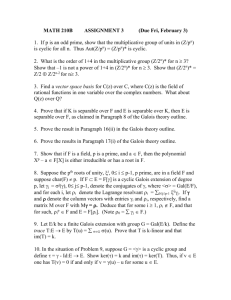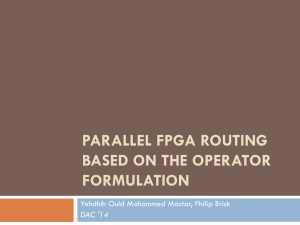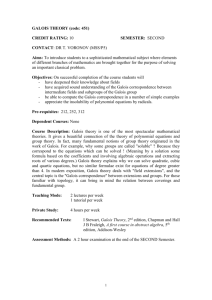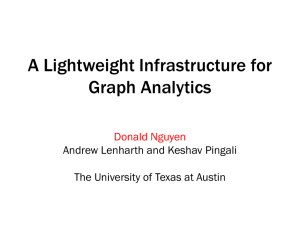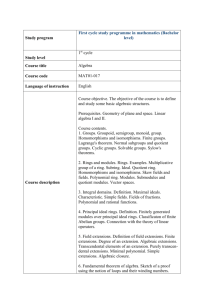The use of 7- blocking sets in Galois geometries
advertisement
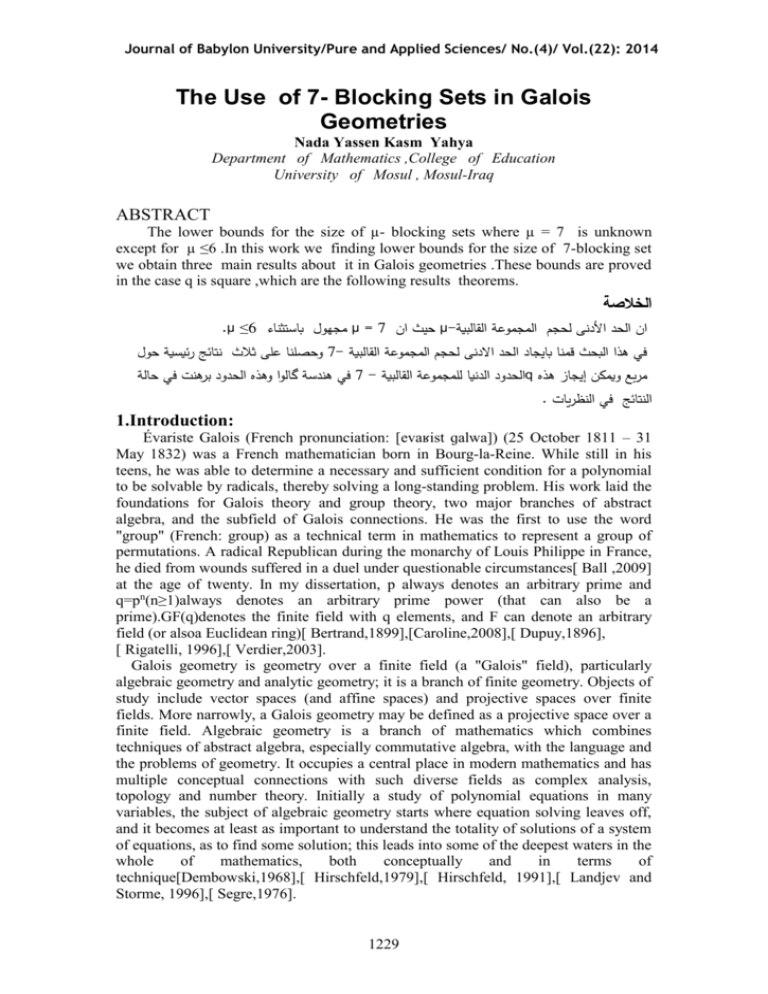
Journal of Babylon University/Pure and Applied Sciences/ No.(4)/ Vol.(22): 2014
The Use of 7- Blocking Sets in Galois
Geometries
Nada Yassen Kasm Yahya
Department of Mathematics ,College of Education
University of Mosul , Mosul-Iraq
ABSTRACT
The lower bounds for the size of µ- blocking sets where µ = 7 is unknown
except for µ ≤6 .In this work we finding lower bounds for the size of 7-blocking set
we obtain three main results about it in Galois geometries .These bounds are proved
in the case q is square ,which are the following results theorems.
الخالصة
.µ ≤6 مجهول باستثناءµ = 7 حيث انµ-ان الحد األدنى لحجم المجموعة القالبية
وحصلنا على ثالث نتائج رئيسية حول7- في هذا البحث قمنا بايجاد الحد االدنى لحجم المجموعة القالبية
في هندسة گالوا وهذه الحدود برهنت في حالة7 - الحدود الدنيا للمجموعة القالبيةq مربع ويمكن إيجاز هذه
. النتائج في النظريات
1.Introduction:
Évariste Galois (French pronunciation: [evaʁist ɡalwa]) (25 October 1811 – 31
May 1832) was a French mathematician born in Bourg-la-Reine. While still in his
teens, he was able to determine a necessary and sufficient condition for a polynomial
to be solvable by radicals, thereby solving a long-standing problem. His work laid the
foundations for Galois theory and group theory, two major branches of abstract
algebra, and the subfield of Galois connections. He was the first to use the word
"group" (French: group) as a technical term in mathematics to represent a group of
permutations. A radical Republican during the monarchy of Louis Philippe in France,
he died from wounds suffered in a duel under questionable circumstances[ Ball ,2009]
at the age of twenty. In my dissertation, p always denotes an arbitrary prime and
q=pn(n≥1)always denotes an arbitrary prime power (that can also be a
prime).GF(q)denotes the finite field with q elements, and F can denote an arbitrary
field (or alsoa Euclidean ring)[ Bertrand,1899],[Caroline,2008],[ Dupuy,1896],
[ Rigatelli, 1996],[ Verdier,2003].
Galois geometry is geometry over a finite field (a "Galois" field), particularly
algebraic geometry and analytic geometry; it is a branch of finite geometry. Objects of
study include vector spaces (and affine spaces) and projective spaces over finite
fields. More narrowly, a Galois geometry may be defined as a projective space over a
finite field. Algebraic geometry is a branch of mathematics which combines
techniques of abstract algebra, especially commutative algebra, with the language and
the problems of geometry. It occupies a central place in modern mathematics and has
multiple conceptual connections with such diverse fields as complex analysis,
topology and number theory. Initially a study of polynomial equations in many
variables, the subject of algebraic geometry starts where equation solving leaves off,
and it becomes at least as important to understand the totality of solutions of a system
of equations, as to find some solution; this leads into some of the deepest waters in the
whole
of
mathematics,
both
conceptually
and
in
terms
of
technique[Dembowski,1968],[ Hirschfeld,1979],[ Hirschfeld, 1991],[ Landjev and
Storme, 1996],[ Segre,1976].
1229
In this paper, PG(d, q) denotes the projective Galois geometry of dimension d over
the finite field GF(q). when one identifies the vector lines of V(N+1, q) as being the
points of PG(N, q),These finite projective spaces PG(N, q) are also called Galois
geometries[Hirschfeld,1979],[ Hirschfeld, 1991].
A µ- blocking set in a projective plane is a set S of points with the property that
each line contains at least µ points of S. A 1- blocking set is known as a blocking set
and is defined with the extra condition that it should contain no line. If µ = 2 or 3 such
sets are known as double or triple blocking sets respectively[Ball ,2009],
[Hirschfeld,1979],[Storme ,2010].Non-trivial µ -blocking set B in PG(2,q)does not
contain a line ,and q+r(q) +1 = size of smallest non-trivial blocking set in PG(2,q)
,r(q) = (q+1)/2 for q>2 prime, r(q) = q for q square ,r(q) =q2/3for q cube
power[Storme ,2010]. From now on ,we will consider non-trivial 7-blocking sets
only. In PG(2,q),q is square a non-trival µ-blocking set B of size q q 1 is called a
Baer subplane with the property that every line joining two points of B contain
precisely , q 1 points of B ,and this line called Baer subline. The field
GF(q) {∞}can be identified with the projective line PG(1,q).it contains the Baer
subline GF( q ) {∞}.[Hirschfeld,1979].
2. µ-Blocking Sets in PG(2,q)
In this section we review the known results containing important information about
the possible sizes of µ-blocking sets in PG(2;q) which we shall use subsequently.
Suppose that 2≤ µ≤q .
Proposition( 2.1) [Ball ,2009]. If B is a proper subset of the points of PG(2;q) and it is
A µ- blocking set then |B|≥ µ(q+1).
Proof: Let PϵPG(2;q)\B be a point not in the blocking set. There are q+ 1 lines
through P and each lines contains at least µ points of B(and these points are distinct).
Theorem (2.2) [Blokhuis ,1994]: Let B be a µ -blocking set with respect to lines in
p 1
PG(2;p) where p is an arbitrary prime. If 2≤ µ≤q then | B | p min
,p
2
Theorem( 2.3) [Ball ,2009]: Let B be a µ -blocking set in PG(2;q). If B contains no
line then it has at least q q 1 points.
Theorem (2.4)[ Blokhuis ,2007]: Let B be a µ -blocking set in PG(2;p), p >3prime.
1. If µ < p/2then |B|≥( µ +1/2)(p+1).
2.If µ>p/2then|B|≥( µ +1)p.
Theorem( 2.5) [Ball ,2009]: Let B be a µ -blocking set in PG(2;q),where
µ<min(q1/6,q1/4/2).if d≥2,p>3,q=p2d then |B|≥ (q q 1)
Theorem( 2.6) [Ball ,2009]: Let B be a µ -blocking set in PG(2;q),where
µ<min(q-1/3,q1/6,q1/4/2).if d≥2,p>3,q=p2d then |B|≥ (q q 1)
The following properties of a Baer subline will be used as well [Hirschfeld, 1979]:
1230
Journal of Babylon University/Pure and Applied Sciences/ No.(4)/ Vol.(22): 2014
1-the intersection of dual Baer subline with line is a Baer subline.
2-two Baer subline intersect in at most two points.
3-if one has two points and two dual Baer subline through these points so that the
line joining the two points belongs to both Baer subline, then the intersection of the
lines of these Baer sublines contain a Baer subplane.
3. Lower Bounds of The Size of 7-Bloking Sets
The object of this section is to obtain good lower bounds for the size of a 7-blocking
sets in PG(2,q),q is square. Using the results in the previous section we are now able
to prove the following .
Lemma(3.1):
Let B be 7-blocking set of size k in PG(2,q);|B|=k ,if L is an i-secant to B ,then
k≥i+7q
Proof : Let P be a point in L\B , since every another line through P containing at least
7 points of B then |B|≥ 7(q+1-1) +i then k≥i+7q.
Theorem(3.2):
Let B be a 7-blocking set in PG(2,q),q is square ) q <7 (,such that
through each of its points there are q 1 lines containing at least q 7
points of B and forming a dual Baer subline ,then |B|≥ 7q 2 q 7 .
Proof:
Calling the line meeting B in at least q 7 points long line if two long lines meet
outside B ,then |B|≥2( q 7 )+7(q+1-2)= 7q 2 q 7 ,If every two long lines meet
in B, let L be a long line and P B not on L.
The long line through P containing a dual Baer subline and meet L in Baer subline ,let
Q be a point on this Baer subline ,consider long lines through a point of 7-secant to Q
these long lines meet L in another Baer subline not containing Q ,since two Baer
subline meet in at most two points ,so L has at least 2( q 1 ) -2=2 q points.
So every long line has at least 2 q points of B. Hence
| B | 1 ( q 1)(2 q 1) 6(q 1 ( q 1)) 8q 5 q
Since 8q-5 q < 7q 2 q 7 ,for
q <7 then |B|≥ 7q 2 q 7 .
Lemma(3.3):
for q <33,q is square let B be a 7-blocking set in PG(2,q),having through every point
at least q 1 lines , containing at least q 7 points of B and forming a dual then
|B|≥ 7q 3 q 7 points.
Proof:
Let B behave fewer than 7q 3 q 7 ,points call lines meeting B in at
least q 7 points long lines ,take 21 points on long line L then at least
21( q ( q 6 )points of B\L laying on the long lines through these 21 points with
1231
multiplicity since B\L containing less than( 7q 3 q 7 )-( q 7 )= 7q 2 q of
points ,so there exists more than21 q ( q 6 )-3( 7q 2 q )=120 q of points on
four or more long lines through 21 points (with multiplicity).
Let P i be a point of B\L joined to at least four of these 21 points on L by long line .let
Si be the point of L at which the long line through P i meet L ,the set Si has most
q 2 points other wise P i lies on at least q 3 long lines. So that B contains at
least 1 ( q 3)( q 6) 6(q q 2) 1 q 9 q 18 6q 6 q 12 7q 3 q 7
The bound obtained (since B has fewer than( 7q 3 q 7 ).
By assumption bi contains a baer subline bi, since there exists 120 q points in
B\L(with multiplicity) meeting four of the 21 points.
There exist 120 q points the corresponding bi of which meet at least three of the 21
21
points .So there are =1330 different sets of three points of these 21 points. There
3
exists P1,P2 correspond to b1,b2 of which meet at least 3 points ,since two a baer
subline meet at least two points , b1≡b2
If 3 long lines meet in P B then B has at least 3( q 7) 7(q 2) 7q 3 q 7
There exists no 3 long lines meet outside B, so there exists at most two long lines
meet outside .The long lines through P1,P2 meet L in at most one point outside B and
the point lies on the long line joining P1,P2.Let S be the set of points of L∩B at which
b1≡b2 meet L∩B ,then S has q or q 1 points. We prove L contains at least
q 9 points of B.First assume L contains less than q 9 points of B, let T be the
set points of B\L that lie on non-long lines meeting S. there exists at least
6( q q 1 )points in T, suppose that L have exactly q 7 points of B, since the
long lines through a point of T meet at most two points of S forming at most 9 points
of a real line points of L ∩ B. Let n be the maximal such that n points of T are
collinear.Each point of B lies on at least q 1 long lines , each point of T have at
least
q 8 long lines meeting L\B .That is there exist q+1-( q 7 )points L\B,
n( q 8 ) ≤ q q 6 ,So n≤ q 8 ,for q >33.Since every point of T has at
least q 8 long lines meting L outside B and at most
q 8 points ,collinear
,then 6(q q 1)( q 8) q q 6 q q 1 contradiction for q >33.
Since L was arbitrary , then every long line containing at least
,assume
q 8 points of B
q 2 of these long lines meet in a point in B.
|B|≥1+( q 2 )( q 7 )+6( q q 1 )= 7q 3 q 9 contradiction.
So every point of B lies on exactly q 1 long line L contains exactly q 8 points
of B ,define S,T and n as before.
q 8
n( q 8 )≤ q q 6 therefore n (q q 1).
q q 6 q q 1 , and
q 8
that also contradiction, q 33. Since L is arbitrary ,then every long line contain at
1232
Journal of Babylon University/Pure and Applied Sciences/ No.(4)/ Vol.(22): 2014
least q 8 points of B. So |B|≥ 1 ( q 1)( q 7) 6(q q ) 7q 2 q 8 ,that
is also contradicts the number of points of B. Hence |B|≥ 7q 3 q 7 ,for q 33.
Theorem(3.4):
(for q <33,q is square ).Let B be a 7-blocking set in PG(2,q),such that each of its
points is one of the following :
(1)the meet of a secant of length 2 q 7 or more and q secant each of length at
least q 7 ;
(2) the meet of two i- secant of length 2 q 7 or more and
q -2 secant each of
length at least q 7 ;
(3) the meet of at least
q 1 lines that meet B in at least
q 7 points and contain
each dual Baer subline then |B|≥ 7q 3 q 7 .
Proof:
Call the secant of length 2 q 7 or more every long line and the secant of length
q 7 long line and call this point of type 3 is special point .if very points of B is of
type 3,then by lemma(3.3) |B|≥ 7q 3 q 7 ,now assume that ɮ is the number of
very long lines and assume ɮ is non-zero and hence B has at least
2 q +7+7q= 7q 2 q 7 points.
Assume B has points fewer than 7q 3 q 7 that implies ,very long line meet long
lines and other very long line in B because if they meet in point meet not in the B,
|B|≥ 7q 3 q 7 .
Assume every very long line has exactly 2 q 7 points, there exists at least
7q+2 q 7 -( 2 q 7 ) ɮ+ ɮ( ɮ-1)/2 special point.
Consider L to be a very long line and P be a special points P L, the long lines
through P meet L∩B in a set containing a Baer subline.
Q in this Baer subline in another Baer subline in L∩B not containing Q. This is
since ,there is a special point on 7-secant through Q so the long lines through Q
containing at most q ( q 6 / 2) special point ,and this always less than the total
number of special point ,so L∩B split into two disjoint dual Baer subline and 5 points
or L has at least 3 q 3 , because very long lines has at least 2 q 7 .
Assume L split into two dual Baer subline and 5 points take Q1 point of type 1 and
Q2 point of type 2 in separate Baer subline in L∩B. if every point of type 1 ɮ=1.if
every point is of type 2,then ɮ=2 q 8 and take two points Q1,Q2 of type 2.The
long line through Q1 containing at most
q ( q 6 (1) / 2) special points.
The long line through Q2 meet at most ( q 2)( q 7 / 2) special point ,the
number of special point joined Q1,Q2 by 7-secant is
7q 2 q 7 (2 q 7) (1) / 2 q ( q 6 (1) / 2 ( q 2)( q 7 / 2)
1/ 2 1/ 2(17 2 q ) 2 5q 19 / 2 q 21 1/ 8(17 2 q ) 2 0.
1233
(for q 33) .Similarly if every point is of type 1,then ɮ=1,and take the two points
Q1,Q2 of type 1.
7q 2 q 7 (2 q 7) ( 1) / 2 2 q ( q 6 ( 1) / 2)
7q 2 q 7 2 q 7 0 2q 12 q
5q 12 q 0(for q 33)
Similarly for ɮ=2 q 8 ,we have
7q 2 q 7 (2 q 7) ( 1) / 2 2( q 2)( q 7 / 2)
5q 19 q 9
Which is positive (for q 33) L contains 3 q 3 special point. a very long line
with more than 2 q 7 points ,this implies there are at least
(2 q 8)( q 2)
(2 q 8) q 2(2 q 8)
(2 q 8) q 2
Because ɮ= 2 q 8 long lines meet at most
q 2 in a point otherwise.
| B | 1 ( q 3)( q 6) 6(q 1 q 3)
7q 3 q 7
If a long line has
q 7 points then it meet at most:
( q 7)( q 1) (q 1 ( q 7)) 2
q 8 q 7 q 1 q 7 2
2q 8 q q 1 2
(2 q 8) q q 1 2
Long lines. Every long line has at least q 8 points . The number of points through
Q1 is at least
1 2 q 7 q ( q 7) 6(q q )
1 2 q 7 q 7 q 6q 6 q
7q 3 q 8
The number of points through Q2
1 2(2 q 7) ( q 2)( q 7) q 1 2 ( q 2)
1 4 q 14 q 5 q 14 6q 6 6 q
7q 3 q 7
Therefore |B| 7q 3 q 7 .
1234
Journal of Babylon University/Pure and Applied Sciences/ No.(4)/ Vol.(22): 2014
References
Ahmad, Ch.A. (2006), Lower Bounds of t-Blocking sets in PG(2,q)and the Existence
of minimal Blocking sets of size 16 and 17 in PG(2,9), M.Sc. Thesis ,University
of Mosul.
AL-Taee ,R.S.D. (2011), Anon PGL(3,q)and non PΓL(3,q)k-arcs in PG(2,32)and
Lower Bounds of 5-blocking set, M.Sc. Thesis ,University of Mosul.
Ball ,S. and Fancsali, Sz. L. (2009),"Multiple blocking sets in finite projective spaces
and improvements to the Griesmer bound for linear codes".Des. Codes
Cryptogr.53, 2, 119–136. http://www.ivsl.org/?language=ar
Bertrand, J. La vie d.(1899), Evariste Galois, par P. Dupuy., Bulletin des Sciences
math´ ematiques.. pages198–212.
Blokhuis ,A. (1994), On the size of a blocking set in PG(2; p), Combinatorica,
14, , 111-114.
Blokhuis ,A., Lovasz,L., Storme ,L. and Szonyi ,T. (2007), On multiple blocking sets
in Galois-planes, Adv. Geom., 7 39-53.
Caroline E., Eavariste Galois(2008) ,un Candid AT AÁL'EÂCole pre ÂPARATOIRE
EN 1829, Revue d’histoire des mathématiques14, p. 289-328.
Dembowski, P. (1968), Finite geometries, Ergebnisse der Mathematik und ihrer
Grenzgebiete, Band 44, Berlin, New York: Springer-Verlag, ISBN 3-54061786-8, MR0233275
Dupuy, P. (1896), La Vie d’Evariste Galois. Annales de l’Ecole Normale, 13,. pages
197–266.
Hirschfeld, J.W.P. (1979), "Projective geometries over finite fields" , Oxford Univ.
Press Oxford.
Hirschfeld, J.W.P. , Thas, J.A. (1991), "General Galois geometries" , Oxford Sci.
Publ. , Clarendon Press.
Landjev and Storme, L.,(1996)" Galois geometries and coding theory". In Collected
Work Galois geometries and applications. NOVA Academic Publishers (Eds.J.
De Beule and L. Storme).
Rigatelli, L. T. (1996). Evariste Galois : (1811–1832). Birkh¨ auser Verlag, CH-4010
Basel, Switzerland.
Segre, B. (1967) , "Introduction to Galois geometries" J.W.P. Hirschfeld (ed.) Atti
Accad. Naz. Lincei, Mem. , 8 pp. 133–236.
Storme ,L . (2010),"The use of blocking sets in Galois geometries and related research
areas", Ghent University, Dept. of Mathematics , Krijgslaan 281 - S22,
9000 Ghent,Belgium Bangalore, August 31, pp.1-62.
Storme, L. and Weiner ,Zs(2000), On1-blocking sets in PG(n ,q), n≥3.Des. Codes
Cryptogr.21
(1–3),
235–251.
(on
pages
65,
68,
and
82).
http://www.ivsl.org/?language=ar
Verdier,N. , 2003, EÂvariste Galois, le matheÂmaticien maudit, Paris : Pour la
Science, coll.«Les geÂnies de la science», no14.
1235

